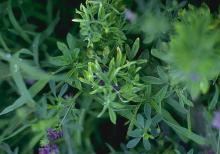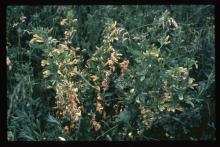Cause Verticillium alfalfae (formerly V. albo-atrum) or V. dahliae, soilborne fungi, may infect numerous plant species without causing foliar symptoms. The disease is in eastern Washington, the Yakima Valley, the Willamette Valley, the Columbia Basin, and irrigated areas in northern, southwestern, and south-central Idaho. Infested seed, infested hay, soil, irrigation water, insects, and contaminated machinery can spread the fungus. Verticillium alfalfae doesn't survive well without a living host though it can persist in dry hay up to 3 years. Verticillium dahliae does produce micro-sclerotia that allow this species to survive many years in the absence of a host. Irrigated fields are the prevalent sites of the disease in the Pacific Northwest.
Symptoms Usually only one or a few stems are affected at first. Early symptoms on these stems occur just before physiological maturity. One or more leaflets exhibit a blotchy yellowing followed by desiccation and chlorosis of a V-shape section of the leaflets. Sectoring later spreads to the entire leaflet. Stems remain green and erect as leaves yellow. Later the stem yellows but remains erect with leaves attached. Internally, the stems show a light orange discoloration near the plant crown or even higher as the disease progresses. Usually, the root is discolored near the crown, but other crown- or root-invading fungi can also cause similar discoloration.
Cultural control
- Using resistant varieties is effective in controlling this disease. The varieties, Apollo II, Trumpter, Vernema, WL 316, and AT-4 are resistant.
- Plant clean seed free of plant debris.
- Crop rotations of 2 to 3 years can minimize the pathogen but must be accompanied by intensive weed management because the pathogen survives on many broadleaf weeds.
- Mow clean fields or younger fields first, and disinfect machinery between fields.
- Dry heat at 167°F (75°C) for 5 hours kills the fungus in seed.
Chemical control Treating seed with a fungicide to eliminate seedborne inoculum is not effective.
Biological control
- Bexfond at 7 to 14 fl oz/A. 4-hr reentry. O
Reference Stuteville, D.L., and Erwin, D.C. 1990. Compendium of Alfalfa Diseases, 2nd ed. St. Paul, MN: APS Press.



